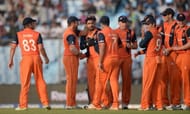In 2011, almost immediately after arguably the most commercially successful One Day Cricket World Cup, the International Cricket Council (ICC) made the bold decision to announce that they would streamline the 2015 and 2019 events to only include the ten full ICC Member Nations.
There was much outcry from Associate nations, especially after the 2011 edition of the World Cup, when Associate nation Ireland had upset a full member nation and had exceeded expectation in their performances.
Common sense was shortly restored, as the then ICC President Sharad Powar, asked the ICC to reconsider its decision, and now four Associate member nations will compete in next year’s showcase tournament.
Many of those who oppose Associate nations, or minnows, from competing in ICC showcase events argue that the inclusion of the minnows diminishes the quality of cricket in these important tournaments, in the process unnecessarily prolonging World Cups – often already seen as too long by even the keenest of observers.
While the minnows offer the occasional upset in the One Day World Cups, which provide the spark of excitement which is often needed in the group stages of the tournament, generally they are dispatched away with ease by the established teams. The 2013 ICC Champions Trophy was streamlined to only the top eight ranked ODI teams, with no room for Associates, or bottom of the rung Bangladesh and Zimbabwe. The compact nature of the tournament was deemed a success by fans and broadcasters alike – indicating that a quick tournament is a good one.
However, the game’s shortest format, T20, affords cricket with its greatest opportunity to globalise the game. The short compact format of the games is easier to comprehend by markets where cricket isn’t a tradition. Besides the time in which it takes to play a T20, roughly three hours, being an attractive selling point to non-traditional cricketing nations – it is more likely to feature upsets than the longer two formats.
Ian Chappell recently stated that “one team only needs to have an exceptionally good over, or the other a particularly bad one, and the complexion of the game can change dramatically”. In fact since the first edition of the World T20 in 2007, there have been more upsets involving minnows in World T20s than in ODIs – whether they be in a World Cup or in a bilateral series.
In 2007, the highly rated Australians were undone by a Zimbabwean outfit who hadn’t seen much cricket at the highest level in recent years. In the second edition in 2009, the first game involving hosts England against Associates Netherlands, ended with an unforgettable upset in which the Dutch had beaten England at the home of cricket. Later on in that edition, Ireland – two years prior to their exploits in the 50 over World Cup, beat perennial under achievers Bangladesh.
This year’s ongoing World T20 in Bangladesh is the first to be expanded to allow for more Associate nations. The new format has shown the unpredictability of the T20 cricket. Going into Round 1, Bangladesh, and one of Afghanistan, Ireland or Zimbabwe were expected to gain entry into the Super 10s. Bangladesh and Zimbabwe, were obvious choices for favourites, being full member nations with Test status, while Ireland and Afghanistan have constantly been performing better than most associates in the ICC World Cricket League.
Unexpected victories to Hong Kong, Nepal and the Netherlands over Bangladesh, Afghanistan and Ireland respectively added a spark to the tournament. However, in the Super 10s, the same old “minnow-bashing” script continued with Bangladesh being comprehensively beaten by reigning Champions West Indies, and the Netherlands posting the lowest T20I score ever of 39 against Sri Lanka.
But the Netherlands redeemed themselves by narrowly missing out on a famous victory in their next match, going down to South Africa by 6 runs. They may not have won the game, but they did win plenty of fans and the respect of one of the most feared oppositions in the world at the moment.

Netherlands have sometimes failed spectacularly, but when they have risen, the world has took notice
The minnows might be there to only fill in the numbers, but having them there does serve a purpose. Besides growing the game globally, involving the minnows in these tournaments helps these nations immensely. Afghanistan, the recent recipients of the Laureus “Spirit of Sport” Award for their swift rise in cricket – having bagged three consecutive World T20 berths, and now a maiden qualification for the 2015 One Day World Cup – have used cricket as a nation building tool after decades of war, much like South Africa did with rugby after the fall of apartheid.
They may provide the occasional upset, and more often than not are beaten handsomely by the big boys, but the Associates have a place in ICC tournaments. Globalizing the game aside, there’s always a bigger picture.
Brand-new app in a brand-new avatar! Download Cric Rocket for fast cricket scores, rocket flicks, super notifications and much more!
